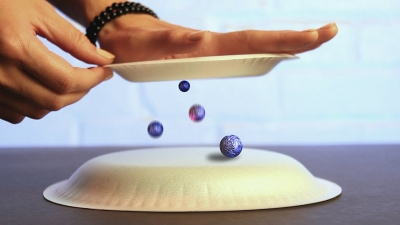
What you need:
Small Styrofoam balls (the kind used in confetti)
A cloth
Aluminium foil
A polycarbonate sheet (thick clear plastic you can find it at a furniture store in your area: you can even use a clear plastic lid from a kitchen container)
Four flat pieces of wood or small cardboard boxes
What to do:
1. Cut the foil into small square pieces. Wrap each Styrofoam ball in the aluminium foil square. Wrap at least 10-12 balls.
2. Shape a sheet of aluminium foil into a makeshift tray (keep the edges lifted up).
3. Weigh the comers of the foil-tray down with the blocks of wood.
4. Now, place the aluminium-coated balls on the foil.
5. Place the polycarbonate sheet on top of the wooden blocks so that it is lifted up.
6. Gently, nub the polycarbonate sheet with the cloth for a few seconds. Now, touch the surface of the sheet with your finger.
What happens:
As soon as you rub the plastic sheet with the cloth, the balls lift up from the aluminium tray and stick to the plastic. Then, when you trace your finger on the sheet, the balls begin to dance away from your finger!
Why?
The answer is static electricity? Static means stationary. When you rub two objects against each other (like the polycarbonate sheet and the cloth), they develop stationary electrical charges. To understand why this happens, we have to go to the microscopic level. Everything in our world is made up of tiny particles called ‘atoms. These atoms are, in turn, made up of even smaller particles known as electrons, protons and neutrons. The protons and neutrons remain inside the atom but the electrons like to use any excuse to jump in and out of the atom. When you rub two objects together, the electrons from one object jump to the other. This exchange of electrons is what is termed as electrical charge.
Electrical charges attract or repel each other depending on their kind. If two objects have same electrical charges, these charges repel each other. Opposite charges, on the other hand, attract. The plastic sheet and the balls seem to have opposing charges on them.
So the balls stick to the sheet. When you move your finger on the sheet, you disturb the charge on the sheet, causing the balls to shift.
Picture Credit : Google




